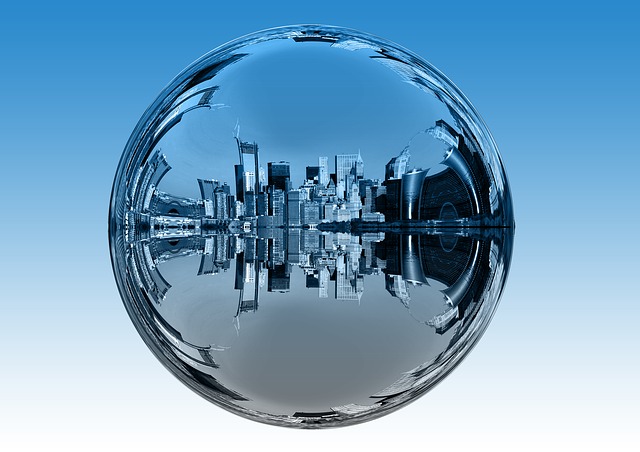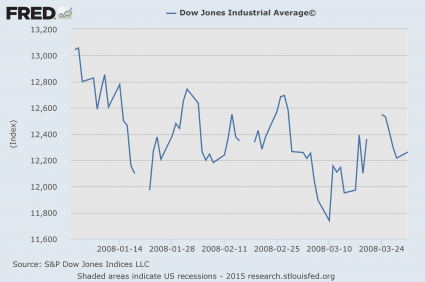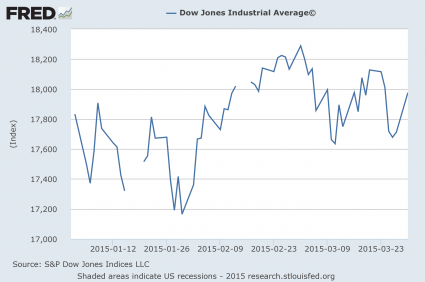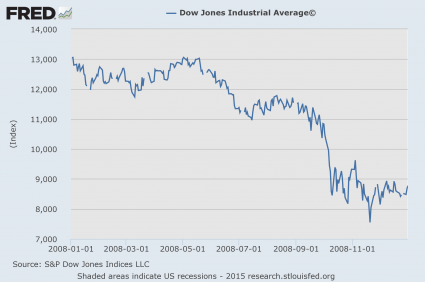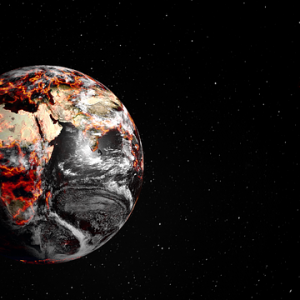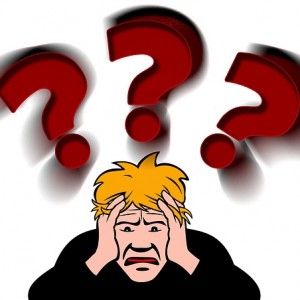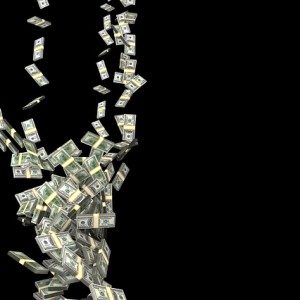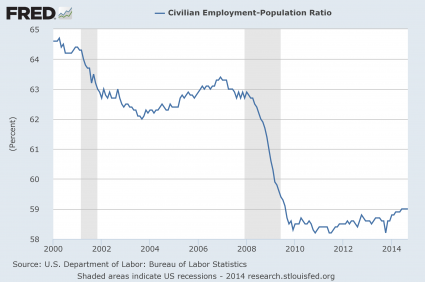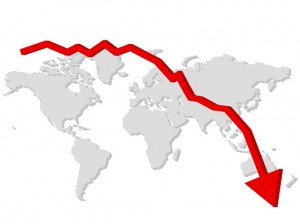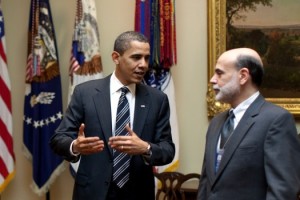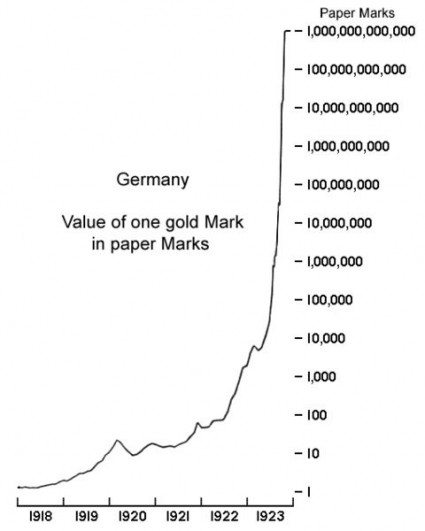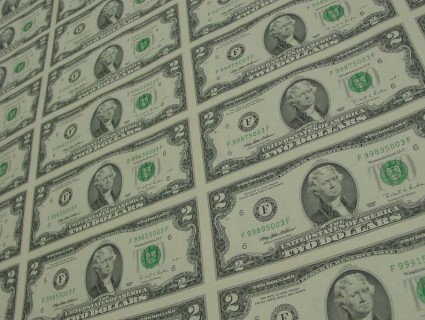 Are we watching a replay of the last financial crisis? Over the past six months, the price of oil has collapsed, the U.S. dollar has soared, and a whole bunch of other patterns that we witnessed just before the stock market crash of 2008 are repeating once again. But what we have not seen yet is the actual stock market crash. So will there be one this year? In this article, I am going to compare the performance of the Dow Jones Industrial Average during the first three months of 2008 to the performance of the Dow Jones Industrial Average during the first three months of 2015. As you will see, there are some striking similarities. And without a doubt, we are overdue for a major market downturn. The S&P 500 has risen for six years in a row, but it has never had seven up years consecutively. In addition, there has not even been a 10 percent stock market “correction” is almost three and a half years. So will stocks be able to continue to defy both gravity and the forces of economic reality? Only time will tell.
Are we watching a replay of the last financial crisis? Over the past six months, the price of oil has collapsed, the U.S. dollar has soared, and a whole bunch of other patterns that we witnessed just before the stock market crash of 2008 are repeating once again. But what we have not seen yet is the actual stock market crash. So will there be one this year? In this article, I am going to compare the performance of the Dow Jones Industrial Average during the first three months of 2008 to the performance of the Dow Jones Industrial Average during the first three months of 2015. As you will see, there are some striking similarities. And without a doubt, we are overdue for a major market downturn. The S&P 500 has risen for six years in a row, but it has never had seven up years consecutively. In addition, there has not even been a 10 percent stock market “correction” is almost three and a half years. So will stocks be able to continue to defy both gravity and the forces of economic reality? Only time will tell.
Below is a chart that shows how the Dow Jones Industrial Average performed during the first three months of 2008. It was a time of increased volatility, but the market pretty much went nowhere. This is typical of what we see in the months leading up to a market crash. The markets start getting really choppy with large ups and large downs…
This next chart shows how the Dow Jones Industrial Average has performed during the first three months of 2015. Once again, we are witnessing a time of increased volatility, but the market is not really going anywhere. In fact, after falling about 200 points on Tuesday (not shown on this chart) it is just barely below where it started the year…
When the market becomes quite restless but it doesn’t really move anywhere, that is a sign that we have reached a turning point. The following is what a recent CNN article had to say about the rising volatility that we have been witnessing…
The Dow fell nearly 3.7% in January, surged 5.6% in February and is down about 2% this month. The S&P 500 and Nasdaq have gone through similar sentiment swings. The Dow ended the quarter slightly in the red while the S&P 500 and Nasdaq were up a little bit.
Charles Schwab chief investment officer Liz Ann Sonders summed up this volatility the best — with a nod to U2. “Running to Stand Still: Wild Swings Taking Market Nowhere” is the title of her most recent market commentary.
What can investors expect for the rest of 2015? Probably a lot more of the same.
Now let’s look at a chart for the entire year of 2008. After peaking for the year in early May, the Dow started to slide. Things started to get really crazy in September, and by the end of the year the U.S. economy was plunged into the greatest crisis since the Great Depression…
Will the rest of 2015 follow a similar pattern?
A lot of investors are actually betting that this will be the case.
Right now, hundreds of millions of dollars are flowing into VXX – an ETF that makes money when the Chicago Board Options Exchange Volatility Index goes up. In other words, these investors are betting that we are going to see a lot more stock market volatility in the weeks and months to come.
And as I have said so many times before, stocks tend to rise in calm markets and they tend to fall when the markets become volatile.
So essentially these investors are betting that we are headed for a stock market crash.
The following is more on the massive inflow of money into VXX that we have been seeing from the Crux…
Ways to speculate on how noisy the stock market will be have exploded in the last decade with the advent of products tied to the Chicago Board Options Exchange Volatility Index. Strategies include relatively simple hedges against equity losses, such as owning a security that aims to mimic the VIX.
VXX, one of the most popular ways to bet on bigger market swings, has absorbed $715 million in seven consecutive weeks of inflows, its longest streak of inflows since one ending in July 2012. The infusion of fresh cash has continued this week, swelling its market value to $1.5 billion, the highest since September 2013.
At the same time, short-sellers in VXX — people effectively betting the bull market will persist — have dropped out. Short interest has slid 35 percent since October, falling to the lowest in more than seven months last week, data compiled by Markit Ltd. show.
And many of the exact same people that warned us about the financial crisis of 2008 in advance are warning that another crisis is rapidly approaching. For example, check out the following quote from Ann Pettifor that recently appeared in an article in the Guardian…
As Janet Yellen’s Federal Reserve prepares to raise interest rates, boosting the value of the dollar, while the plunging price of crude puts intense pressure on the finances of oil-exporting countries, there are growing fears of a new debt crisis in the making.
Ann Pettifor of Prime Economics, who foreshadowed the credit crunch in her 2003 book The Coming First World Debt Crisis, says: “We’re going to have another financial crisis. Brazil’s already in great trouble with the strength of the dollar; I dread to think what’s happening in South Africa; then there’s Malaysia. We’re back to where we were, and that for me is really frightening.”
Pettifor is right on two counts – another major financial crisis is approaching, and it is going to be global in scope.
Before I end this article, there are two more items that I would like to share with you.
Firstly, it is being reported that the IPO market has really cooled off in 2015. When the number of companies going public starts to decline, that is a clear sign that a stock market bubble is on borrowed time. The following comes from Business Insider…
The number of US companies going public has really dropped off lately.
“After a record year in 2014, the IPO market slowed dramatically in the first quarter of 2015,” Renaissance Capital analysts said.
The first quarter of 2015, which ended Tuesday, was the slowest quarter for IPOs since the first quarter of 2013. While stock prices have been near all-time highs, market volatility has been escalating, turning companies off from trying to unload shares onto the public markets.
Secondly, the San Francisco housing market has been a pretty reliable indicator of previous economic booms and busts. The San Francisco housing market started to cool off before the dotcom bubble burst, it started to cool off before the stock market crash of 2008, and now it is cooling off once again. The following chart comes from Zero Hedge…
The warning signs are there.
But as with so many other things in life, most people are going to end up believing precisely what they want to believe.
So what do you believe about what the rest of the year will bring? Please feel free to share your thoughts by posting a comment below…
